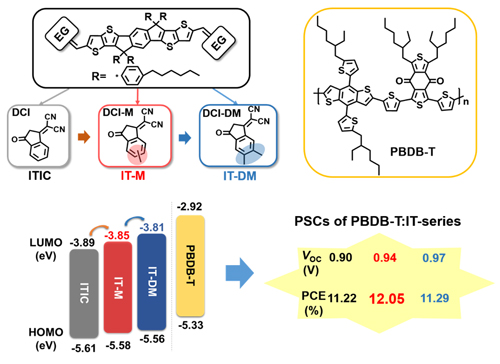As the emerging frontier research field, polymer solar cells are mainly benefiting from the design and development of photoactive layer materials (including electron donors and electron acceptor materials). Among them, modulating the front-rail energy level of a material through the rational design of the molecular structure is a very effective strategy for increasing the open-circuit voltage of the device. In recent years, under the strong support of the Chinese Academy of Sciences, the National Natural Science Foundation of China, the Beijing Science and Technology Commission, and the Institute of Chemistry of the Chinese Academy of Sciences, the State Key Laboratory of Macromolecular Physics and Chemistry, Professor Hou Jianhui’s team of researchers on polymer donor materials Level modulation has been studied in depth. They stated that by reducing the HOMO level of donor materials, it is possible to achieve an increase in the open circuit voltage of the corresponding photovoltaic device and ultimately a higher energy conversion efficiency (Chem. Rev. 2016, 116, 7397-7457; Polym. Int. 2015 , 64, 957-962).
Chemical modification of traditional fullerene receptors is more difficult with respect to the donor material. However, it is encouraging that previous researchers achieved energy conversion efficiencies of more than 11% in non-fullerene polymer solar cells (Sci. China Chem. 2016, DOI: 10.1007/s11426-016-0198-0). This result is already very close to the highest efficiency of conventional fullerene solar cells. In addition, compared to fullerene type devices, non-fullerene type devices have more excellent stability, so further development of such photovoltaic devices is imperative.
Thanks to the successful implementation of energy level regulation of donor materials in recent years, researchers have conducted research on the precise regulation of the energy levels of non-fullerene acceptor materials. Recently, for the first time, they have achieved precise control of the LUMO energy level of the receptor material by introducing weak electron donating groups at both ends of the small molecule receptor (Adv. Mater. 2016, DOI: 10.1002/adma.201602776). The results show that the modification of electron-donating groups at specific sites can effectively improve the LUMO energy level while ensuring that the HOMO energy level of the materials is almost constant, while the number of electron-donating substituents increases. The LUMO level of the material achieves a stepwise increase. Therefore, the open-circuit voltage of the corresponding device is increased from the original 0.90 V to 0.94 V and 0.97 V, respectively. What is more worth pointing out is that due to the small steric hindrance of the substituent group, the material's stacking characteristics hardly change and the ideal blend film morphology is maintained. As a result, non-fullerenes solar cell devices constructed with the donor material PBDB-T and the acceptor material IT-M achieved further breakthroughs in efficiency and achieved a record energy conversion efficiency of 12.05%. The efficiency of this battery has been certified by the China Institute of Metrology, and it has reached 11.6%. This is the single-junction organic solar cell with the highest certified efficiency. At the same time, this work also shows the importance of accurate energy level modulation of the acceptor material, which will greatly promote the development of acceptor photovoltaic materials.

High Strength Bolt,Cup Head Bolt,Extra Large Bolt,Hex Head Inside Bolts
Handan Changlan fasteners manufacturing ,.Co ltd , https://www.hdchanglanjgj.com